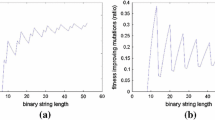Abstract
Recently, genetic programming has been proposed to model agents' adaptive behavior in a complex transition process where uncertainty cannot be formalized within the usual probabilistic framework. However, this approach has not been widely accepted by economists. One of the main reasons is the lack of the theoretical foundation of using genetic programming to model transition dynamics. Therefore, the purpose of this paper is two-fold. First, motivated by the recent applications of algorithmic information theory in economics, we would like to show the relevance of genetic programming to transition dynamics given this background. Second, we would like to supply two concrete applications to transition dynamics. The first application, which is designed for the pedagogic purpose, shows that genetic programming can simulate the non-smooth transition, which is difficult to be captured by conventional toolkits, such as differential equations and difference equations. In the second application, genetic programming is applied to simulate the adaptive behavior of speculators. This simulation shows that genetic programming can generate artificial time series with the statistical properties frequently observed in real financial time series.
Similar content being viewed by others
References
B. Arthur, On learning and adaptation in the economy, Santa Fe Institute Economic Research Program, 92–07–038 (1992).
B. Arthur, J. Holland, B. LeBaron, R. Palmer and P. Tayler, Asset pricing under endogenous expectations in an artificial stock market, Santa Fe Institute Working Paper Series (1996).
F. Black, Noise, Journal of Finance 41 (1986) 529–543.
T. Bollerslev, Generalized auroregressive conditional heteroskedasticity, Journal of Econometrics 31 (1986) 307–327.
T. Bollerslev, R. Chou and K. Kroner, ARCH modeling in finance: A review of theory and empirical evidence, Journal of Econometrics 52 (1992) 5–59.
R.L. Brown, J. Durbin and J.M. Evans, Techniques for testing the constancy of regression relationship over time, Journal of Royal Statistical Society, B 37 (1975) 149–163.
S.-H. Chen and C.-W. Tan, Measuring randomness by Rissanen's stochastic complexity: Applications to the financial data, in: ISIS: Information, Statistics and Induction in Science, eds. D.L. Dowe et al. (World Scientific, Singapore, 1996) pp. 200–211.
S.-H. Chen and C.-W. Tan, Measuring stock market efficiency by Rissanen's predictive stochastic complexity, in: Managing International Business in the Twenty First Century: Decision Making, Market Development, Information and Technology, Vol. 1, eds. H. Steele and N. Antonio, CIBS (Lingnan College and Macau Foundation Press 1996) pp. 159–172.
S.-H. Chen and C.-W. Tan, Modeling the inductive learning agents in financial markets with the adaptive MDL, Presented at The 1996 Chinese Society of Statistics Annual Meeting, June 1, 1996, National Tsing Hwa University, Hsinchu, Taiwan, R.O.C.
S.-H. Chen and C.-H. Yeh, Genetic programming learning and the cobweb model, in: Advances in Genetic Programming, Vol. 2, ed. P. Angeline (MIT Press, Cambridge, MA, 1996) pp. 443–466.
S.-H Chen and C.-H. Yeh, Modeling speculators with genetic programming, in: Evolutionary Programming VI, eds. P. Angeline et al., Lecture Notes in Computer Science, Vol. 1213 (Spewringer-Verlag, Berlin,1997) pp. 137–147.
S.-H. Chen, J. Duffy and C.-H. Yeh, Genetic programming in the coordination game with a chaotic best-response function, in: Proceedings of the Fifth Annual Conference on Evolutionary Programming(EP'96), eds. P. Angeline et al. (MIT Press, Cambridge, MA, 1996) pp. 277–286.
P. Davidson, Is probability theory relevant for uncertainty? A post Keynesian perspective, Journal of Economic Perspectives 5(1) (1991) 129–143.
P.J.F. de Lima, Nonlinearities and nonstationarities in stock returns, Working Paper, Department of Economics (Johns Hopkins University, 1997).
A. De Vany, Information, bounded rationality, and the complexity of economic organization, Taiwan Journal of Political Economy 2(1) (1966) 21–44.
D.L. Dowe and K.B. Korb, Conceptual difficulties with the efficient market hypothesis: Towards a naturalized economics, in: ISIS: Information, Statistics and Induction in Science, eds. D.L. Dowe et al. (World Scientific, Singapore, 1996) pp. 200–211.
M. Ezekiel, The cobweb theorem, Quarterly Journal of Economics 52 (1938) 255–280.
T. Haavelmo, The probability approach in econometrics, Econometrica 12 (1944) 1–18, supplement.
J.D. Hamilton, Time Series Analysis(Princeton University Press, 1994).
J.D. Hamilton and R. Susmel, Autoregressive conditional heteroskedasticity and changes in regime, Journal of Econometrics 64 (1994) 307–333.
R.E. Kalman, Randomness reexamined, Modeling, Identification, and Control 15(3) (1994) 141–151.
J.R. Koza, Genetic Programming: On the Programming of Computers by Means of Natural Selection(MIT Press, 1992).
C.-M. Kuan and T. Liu, Forecasting exchange rates using feedforward and recurrent neural networks, Journal of Applied Econometrics 10 (1995) 347–364.
A. Leijonfhufvud, Towards a not-too-rational macroeconomics, Southern Economic Journal 60(1) (1993) 1–13.
T. Lensberg, A genetic programming experiment on investment behavior under knightian uncertainty, in: Genetic Programming 1997, Proceedings of the Second Annual Conference, July 13–16, 1997, Stanford University, eds. J. Koza et al. (Morgan Kaufmann, San Francisco, CA, 1997) pp. 231–239.
M. Li and P. Vitanyi, An Introduction to Kolmogorov Complexity and its Applications(Springer, 1993).
A. Marcet and T. Sargent, Convergence of least squares learning mechanisms in self referential linear stochastic model, Journal of Economic Theory 48 (1989) 337–368.
J.F. Muth, Rational expectations and the theory of price movements, Econometrica 29 (1961) 315–335.
J.R. Neil and K.B. Korb, The MML evolution of classification graphs, in: ISIS: Information, Statistics and Induction in Science, eds. D.L. Dowe et al. (World Scientific, 1996) pp. 78–89.
J. Rissanen, Stochastic Complexity and Statistical Inquiry(World Scientific, 1989).
T. Sargent, Bounded Rationality in Macroeconomics(Oxford, 1993).
R. Solomonoff, Does algorithmic probability solve the problem of induction, Invited paper given at the Conference on Information, Statistics and Induction in Science, Melbourne, Australia, August 20–23 (1996).
K. Velupillai, The computable approach to economics, Taiwan Journal of Political Economy 1(1) (1995) 53–110.
Rights and permissions
About this article
Cite this article
Chen, SH., Yeh, CH. Simulating economic transition processes by genetic programming. Annals of Operations Research 97, 265–286 (2000). https://doi.org/10.1023/A:1018972006990
Issue Date:
DOI: https://doi.org/10.1023/A:1018972006990




